King Charles III's new official portrait: What the butterfly means
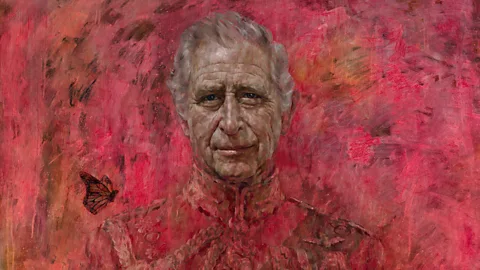 Jonathan Yeo Studio
Jonathan Yeo StudioAs a new official portrait of King Charles III is unveiled, a guide to the messages in recent royal iconography.
In the year since the Coronation of King Charles III, the official images that have been unveiled – created by leading painters and photographers, etchers and engravers – reveal much about his interests. And one in particular comes through powerfully.
From the surface of countless objects encountered every day in the United Kingdom, including coins and postage stamps, intricate insignias and official portraits, a surprisingly personal message about the fragility of our world has begun to vibrate back – an urgent appeal enunciated in a vivid visual language that is remarkably fresh and new. To mark the first anniversary of the Coronation in May 2023, here is a symbol-spotter's guide to the intriguingly eco-conscious iconography of King Charles III.
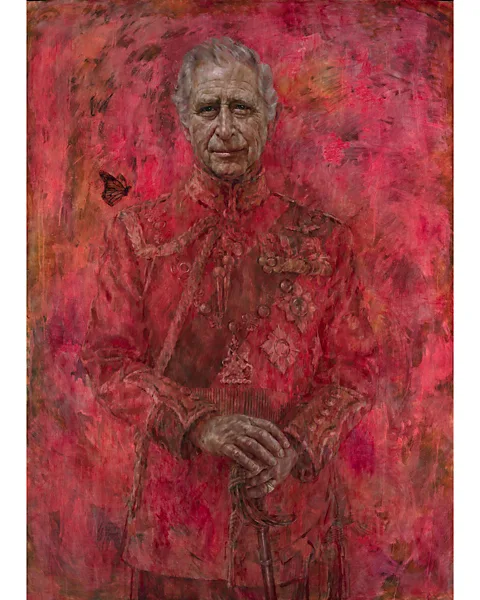 Jonathan Yeo Studio
Jonathan Yeo StudioThe Yeo portrait
If the first official portrait of the King to be unveiled since his Coronation is anything to go by, symbols of his devotion to ecological causes are likely to remain a leading leitmotif of royal iconography throughout his reign. The larger-than-life likeness, which measures 8ft 6in by 6ft 6in, is the work of British artist Jonathan Yeo, who has previously painted the King's father, Prince Philip, the late Duke of Edinburgh, and Charles's wife, Queen Camilla. Here, the uniformed figure of Charles appears to be emerging from a heavy haze – a vivid vermillion mist that tinges everything save the King's incongruously serene face, his sympathetic hands (which rest on his sword's pommel), and a small monarch butterfly about to land on his sovereign shoulder.
In any other era, perhaps, the rejuvenating insect's invocation in such a context might be interpreted straightforwardly as an emblem of royal rebirth – a new monarch beginning to spread his wings. But here, the fug of crimson is too apocalyptic for such easy cheeriness. Some subspecies of the monarch butterfly are, after all, vulnerable to endangerment. Does the butterfly, once a predictable memento mori prop in Old Master still lifes, represent a wider warning – an exhilarating exhortation to pause and appreciate the fine, fragile, fleetingness of life?
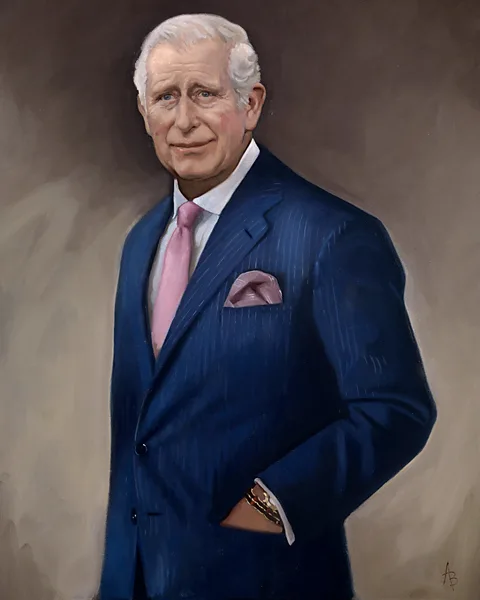 Alastair Barford/Illustrated London News Ltd.
Alastair Barford/Illustrated London News Ltd.The Barford Portrait
That Charles had something urgent and unexpected up his sleeve, optics-wise, was apparent from the very first official portrait of the new King to be released by Buckingham Palace, two months before his coronation. Painted by the British artist Alastair Barford after observing the King host a reception devoted to biodiversity, the oil-on-canvas work captures Charles still raw with emotion over the recent loss of his mother, yet unequivocally commanding the timeless space in which he stands.
Just visible on his left wrist, slipping from under his starched shirt's cuff, is a beaded black and gold bracelet whose unique lustre glisters alluringly. Jewellery is always telling in royal portraiture (just look at the ring, intended to denote piety, that Henry VIII ostentatiously fumbles onto his own finger in a portrait from 1520). The bracelet in the Barford portrait is a gift to the King from the indigenous leader Uyunkar Domingo Peas Nampichkai, spokesperson for the Sacred Headwaters of the Amazon, and quietly calls attention to the plight of the rainforest ecology and to Charles's passionate commitment to protecting the environment more broadly.
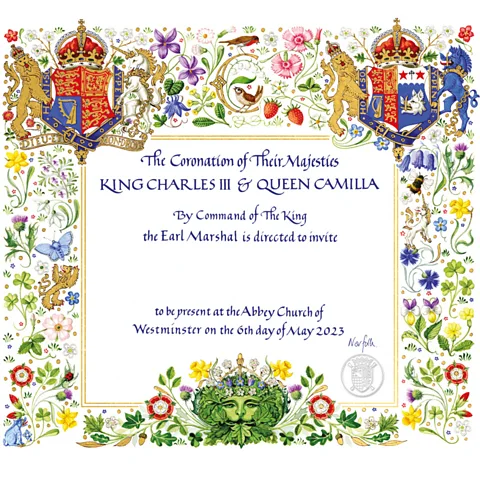 Buckingham Palace
Buckingham PalaceThe Coronation invitation
A month after the unveiling of the first official portrait of King Charles, an invitation to his imminent Coronation, issued by the Palace to some 2000 guests and designed by the heraldic artist and manuscript illuminator, Andrew Jamieson, was made public.
At first glance, the charming announcement, with its predictable prance of lions, unicorns and boars, appears to wear its significations more conspicuously on its sprightly sleeves than Barford's more soulfully sombrous portrait. The broad sylvan border of the invitation bristles with symbols celebrating the union of nations.
The suspended shimmer of shamrocks (for Ireland), thistles (for Scotland), roses (for England) and daffodils (for Wales) is elegantly intertwined with other resonant fruits, flowers and shrubs, from bluebells to strawberries (which the King's mother famously adored), dog roses to rosemary – a conventional symbol of remembrance.
The evocative presence of the so-called "Green Man" at the bottom of the invitation, an ancient emblem of rebirth from which everything seems to spring forth, is matched at the top of the announcement by the curious companionship of a robin and a wren in the composite monogram "C", which stands at once for Charles and Camilla. Why those two birds? A book of provincial proverbs collected by the English antiquary Francis Grose in 1787 might provide a clue. Of that particular pair, "the robin and wren", Grose records a forgotten folkloric warning: "persons killing [them] … or destroying their nests, within the course of the year, will infallibly break a bone, or meet with some other dreadful misfortune".
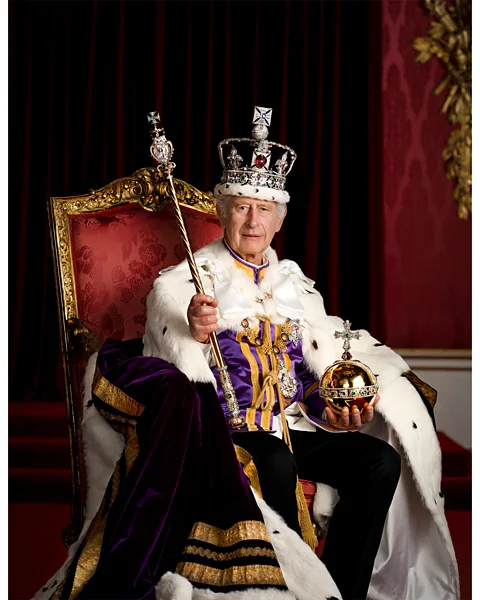 Hugo Burnand/ Royal Household 2023
Hugo Burnand/ Royal Household 2023The Coronation photo
A commitment to protecting the environment is no less evident in the official photograph of the freshly crowned Sovereign captured by Hugo Burnard on the afternoon of the Coronation. However unlikely it may at first seem, Burnand's opulent photo is, in its way, a resplendent directive to reduce, reuse and recycle.
The image is an intense tableau of hand-me-downs. Seated in Buckingham Palace's Throne Room, Charles perches not on a newly crafted cathedra, but on a red satin chair that was made for King George V on the occasion of Edward VII's coronation in 1902. The Sovereign Orb he holds in his left hand (a symbol of the world) and the Sovereign's Sceptre with Cross that he grips in his right (denoting good governance) were both made by the legendary 17th-Century goldsmith Robert Vyner for the 1661 coronation of his namesake, King Charles II, and can be seen brand new, glistening with box-fresh extravagance, in John Michael Wright's 1661 portrait of the King's predecessor.
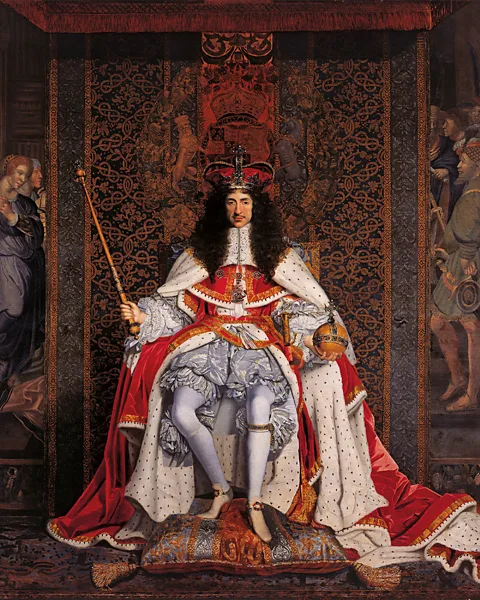 Royal Collection Trust
Royal Collection TrustAlso upcycled for the ceremony is the Imperial State Crown that sits atop Charles's head, which was created for King George VI's coronation in 1937 – the same occasion from which was also salvaged into service the royal purple "Robe of Estate", accented with gold lace and edged with ermine fur, that Charles opted to wear, rather than commission something new. That this comprehensive repurposing of regal trappings was environmentally motivated was clear enough from the Palace's own statement, which noted that the decisions were made "in the interests of sustainability".
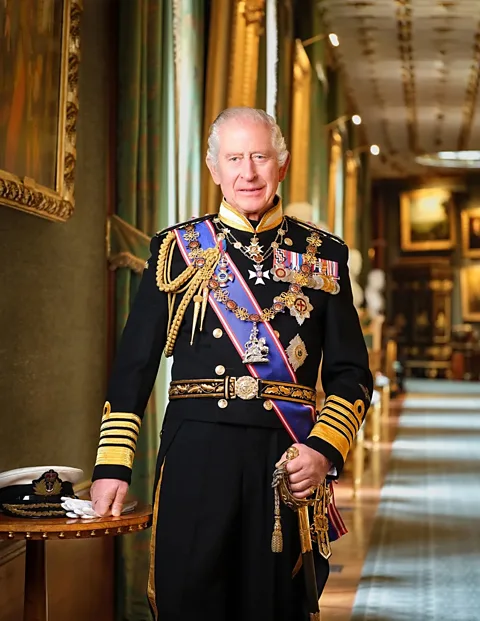 Hugo Burnand/ Royal Household 2024 Cabinet Office
Hugo Burnand/ Royal Household 2024 Cabinet OfficeThe King's portrait for public buildings
When it comes to royal portraits, it is often difficult to know where to focus one's gaze amid the conflicting glimmers of regal glitz. That is certainly the challenge presented by the official likeness of King Charles III unveiled in January 2024, and destined for wide display in public buildings.
For this photograph, Burnard has once again set up the tripod, this time inside Windsor Castle, while the King himself has swapped the archaic ceremonial ensemble of the Coronation for the Admiralty tailcoat of the full Royal Naval Uniform, a polished sword, and an austere smile. But the eye is drawn over the King's left shoulder to the bright light that reflects off a painting of an idyllic landscape that beckons to us blurrily from the far end of the Grand Corridor in which the King stands.
The mingled gleam of the little lamp above the painting's frame, natural sunshine filtering in from the adjacent windows and skylight, and the flash of Burnard's camera, intensifies the painting's summoning haze – an ideal landscape by the hand of Claude Lorrain, say, or JMW Turner. The photographer and the King have given that alluring luminosity too much space, our stare too much runway, for that vanishing point to be incidental, however indistinct it may be. It could be that we're intended to keep the world's fragile beauty in our line of sight, and that the King himself stands ready to defend it.
 Getty Images
Getty ImagesRoyal Mint coins
What better way to ensure that the issue of protecting the environment is kept in constant currency than to echo that concern in currency itself? That at least would appear to be the message behind the new clutch of coins whose fresh design Charles has directly overseen.
While not engraved on to the same surface as the bust of Charles, which adorns the coins' face, the selection of flora and fauna, many at risk of extinction, that have been chosen for the back of the coins reflects the King's deepest concerns. Placed alongside oversized numerals intended to help children learn to count and make change, images of a nestling hazel dormouse (a species whose population has declined by half since 2007) on the 1p, a sprig of oak leaves (merging an age-old emblem of monarchy with a symbol of biodiversity) on the 5p, a poised capercaillie (a species of grouse threatened with extinction) on the 10p, and a leaping Atlantic salmon (under threat from habitat loss and river pollution) on the 50p, are intended to make certain that the environment's plight is a concern that is never far from our fingertips.
--
If you liked this story, sign up for The Essential List newsletter – a handpicked selection of features, videos and can't-miss news, delivered to your inbox twice a week.
